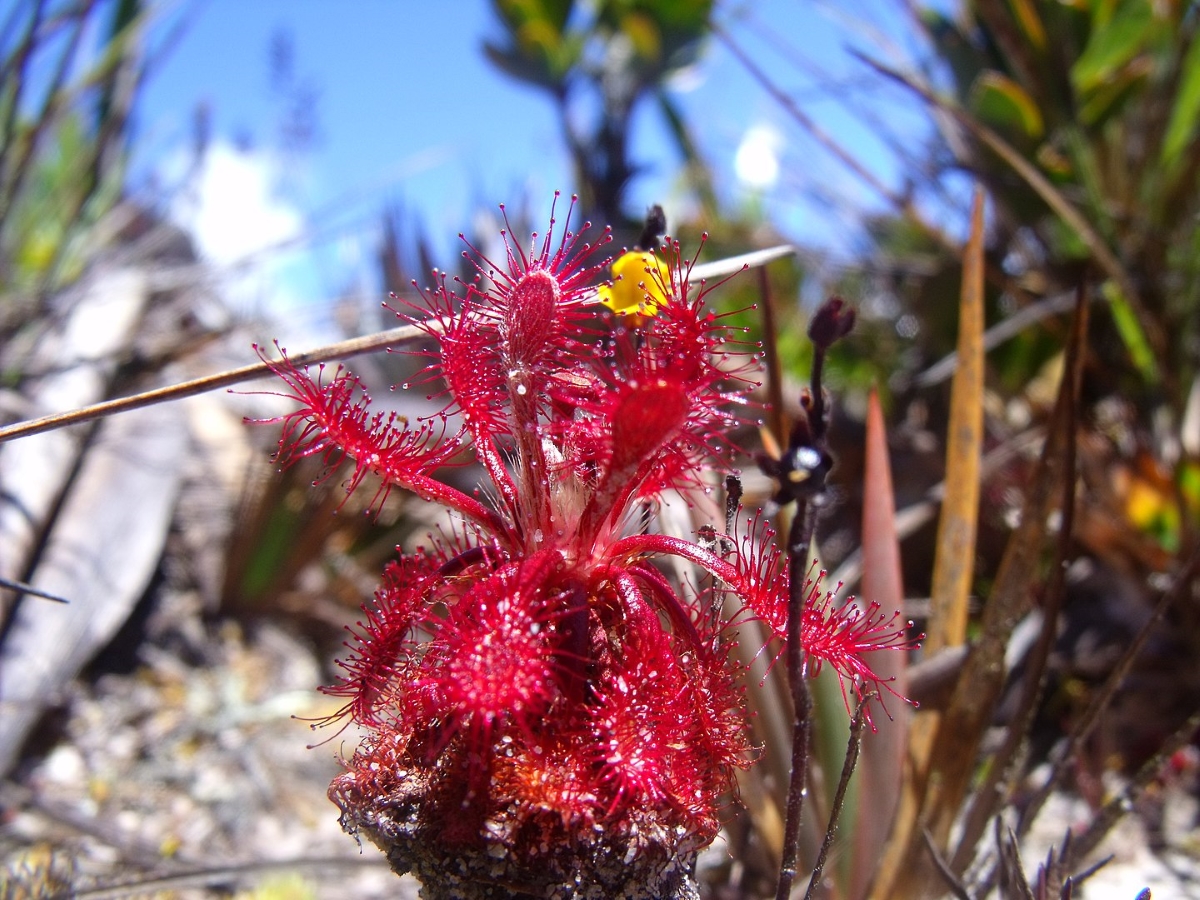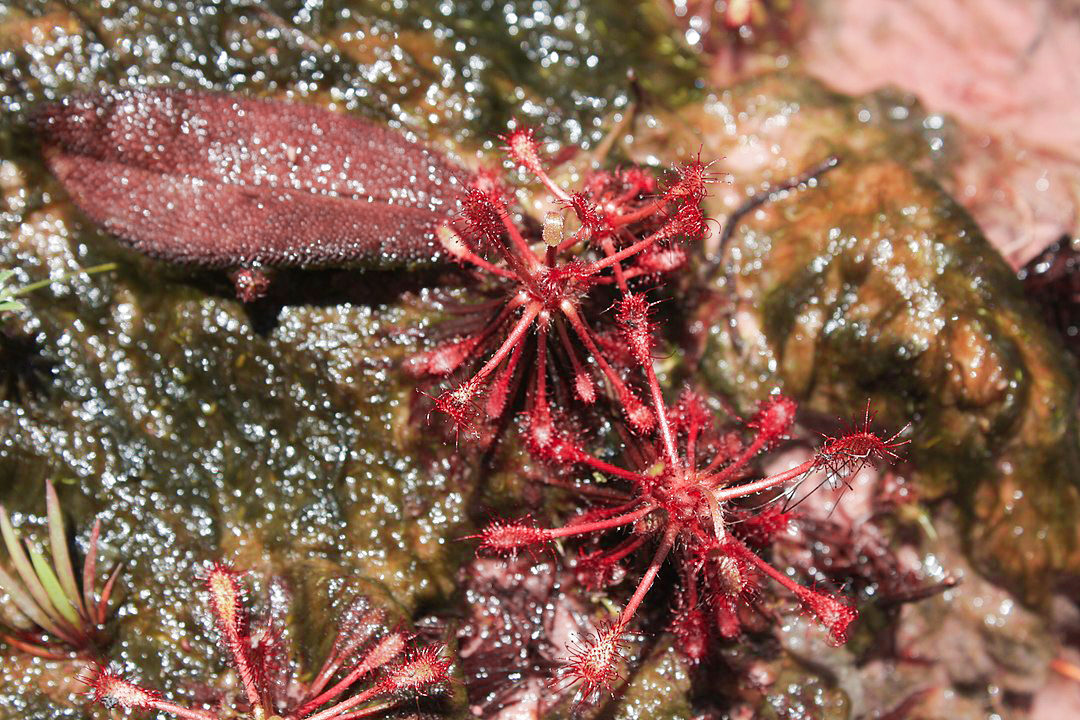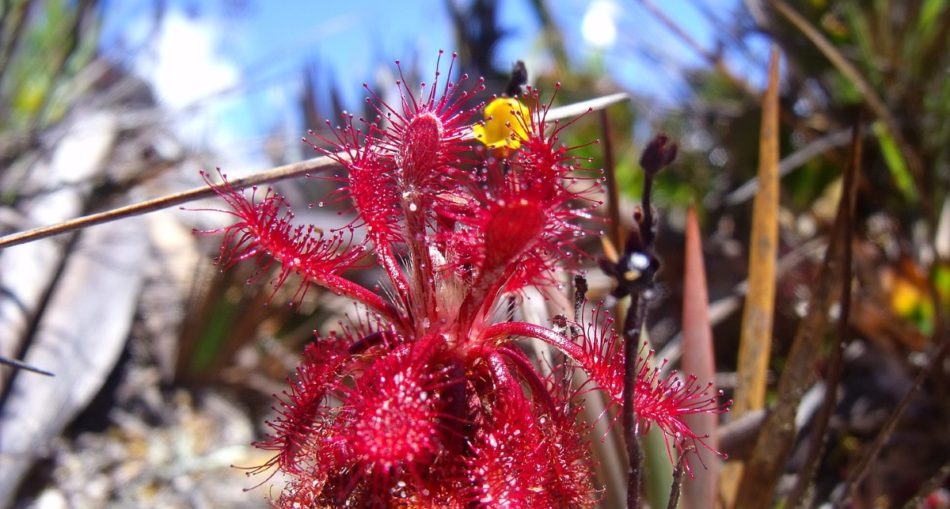The Drosera Roraimae is a type of Carnivorous Sundews which are meat-eating or rather, insect-eating plants. This particular species can be found on the mountaintops of Mount Roraima, in Guyana. These sundews tend to consume insects like mosquitoes, by first luring then trapping them. They can be eat at once or digested slowly. The Drosera roraimae is a species of the Carnivorous Sundew native to Guyana. The plant has long, red tentacles which are attached to the base of the plant. On the tips of these tentacles are glands that produce an adhesive substance that traps an unsuspecting victim. The insect sticks to the plant which secures its prey and digest it.
The Drosera roraimae, named after Mount Roraima, is only one of the Carnivorous Sundews that are found in Guyana. Other plants in the Drosera genus include the Drosera kaieteurensis and the more recently discovered Drosera solaris. Read on to find out how these carnivorous plants lure and trap their unsuspecting preys!
Interesting Tip
- The word “sundew”, derived from the Latin phrase “ros solis” which means dew of the sun. This refers to the shiny droplets of clear mucus typically found on the tips of the hair-like strains called glandular trichomes. These drops even withstand the heat of the day in sun exposure.
- Sundews are called flypaper plants is because insects often get stuck to the surface of the plants.

The Carnivorous Sundew (Drosera roraimae) Photo By Arnaldo Noguera Sifontes – Own work, CC BY-SA 4.0, https://commons.wikimedia.org/w/index.php?curid=49585540
Origin of the Carnivourous Sundew (Drosera roraimae)
The Drosera roraimae is native to Guyana, Venezuela and Brazil. Like the name suggests the Drosera roraima meat-eating plants grow naturally at the top of Mount Roraima.
Scientific Classification of the Carnivourous Sundew (Drosera roraimae)
- Kingdom: Plantae
- Clade: Tracheophytes
- Clade: Angiosperms
- Clade: Eudicots
- Order: Caryophyllales
- Family: Droseraceae
- Genus: Drosera
- Subgenus: Drosera subg. Drosera
- Section: Drosera sect. Drosera
- Species: D. roraimae
Description of the Carnivourous Sundew (Drosera roraimae)
The Drosera roraimae plants are about five (5) to eight (8) cm in diameter, with thin, long leaves with a bulbous tip. At the end of these tips, you can find glands which secrete a sugary, sticky substance, that glues its prey on. Flowers are small, pale greenish-white and always consist of five (5) petals. Like most carnivorous plants, the flowers of the Drosera roraimae are far away from the leaves and usually held up by a very long stem. They are also self-pollinating plants with long roots.

The Carnivorous Sundew (Drosera roraimae) – Photo By: Gabrielplopez – Own work, CC BY-SA 3.0, https://commons.wikimedia.org/w/index.php?curid=32971620
Habitat of the Carnivorous Sundews (Drosera roraimae)
The Carnivorous Sundews seem to prefer seasonally moist habitats but sometimes grow in wet habitats. They require acidic soils and can endure high levels of sunlight. You can find them in swamps, marshes, bogs and tabletop mountains.
Feeding Habits of the Carnivorous Sundews
Unlike a typical plant, the Drosera roraimae does not manufacture its own food during photosynthesis. Instead, it preys upon small insects like mosquitoes. The bright, attractive red colour of the Drosera roraimae captivate the unsuspecting victims and when they land on the plant, they will soon find themselves immobilized, in a rather sticky situation. Soon after this, spindly tendrils of stems would stretch and capture the insect in its embrace. Prey is suffocated or dies through exhaustion. The trapped insect dies approximately fifteen (15) minutes after being caught but can be digested over a period of time. Digestive enzymes are released, which break down the body of the prey, thus allowing for the absorption of nutrients.
Interesting Tip
- The assassin bug is immune to the sticky secretions and likes to hide on the plant to steal the prey.
Uses of the carnivorous Sundew – Drosera roraimae
- In Germany and some parts of Europe, sundews were used in cough preparations, which typically make use of its roots, flowers and fruits.
- A tea made from sundew is used to treat bronchitis, dry and whooping coughs and even asthma.
- Sundews are also used to treat sunburns and to prevent freckling.
- They are believed to strengthen the heart and are an aphrodisiac.
- The Drosera genus is currently used to treat lung infections and stomach ulcer.
- Sundews are desirable plant because of their insect-consuming nature, and distinctive traps atypical of what one would expect of a plant.
About the Carnivourous Sundew (Drosera roraimae)
Drosera roraimae is an interesting species because of its carnivorous nature. Nature has definitely put an interesting to things. The Drosera roraimae is native to Guyana, specifically to the mountaintop or tepuis of the Roraima Mountain. While they are used in medicine, they are also used as decorative plants. If you’re looking for an exotic addition to your garden try the of any related species of the Carnivorous Sundews.
Article Reference
- http://www.karnivores.com/en/carnivorous-plants-sale/carnivorous-plants/drosera/drosera-intermedia-mt-roraima-venezuela
- https://en.wikipedia.org/wiki/Drosera_roraimae#:~:text=Drosera%20roraimae%20is%20a%20sundew,the%20type%20specimen%20was%20collected.
- https://www.rarexoticseeds.com/en/drosera-roraimae-seeds-south-american.html
- https://en.wikipedia.org/wiki/Drosera_kaieteurensis
- https://en.wikipedia.org/wiki/Drosera








1 Comment